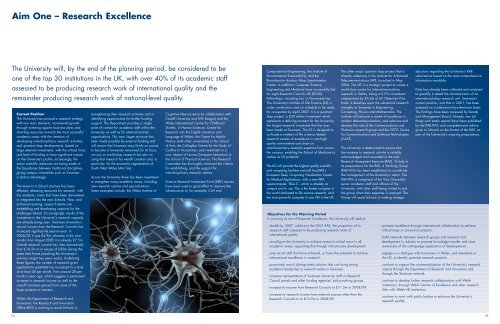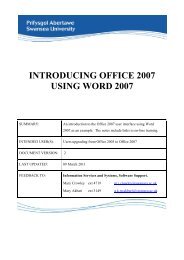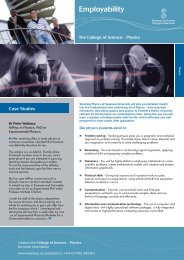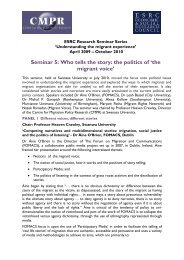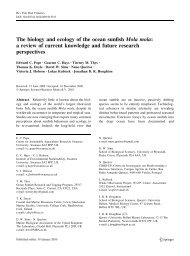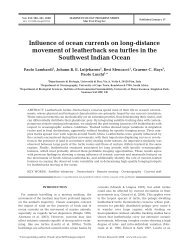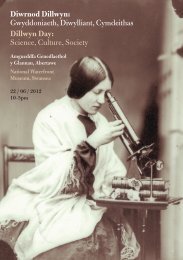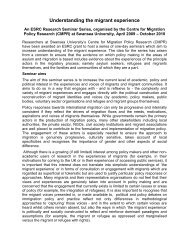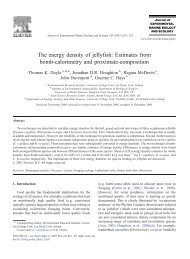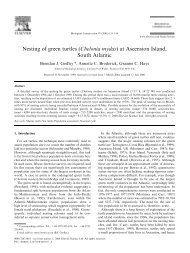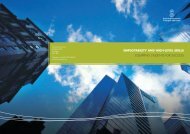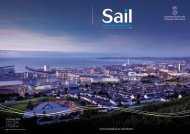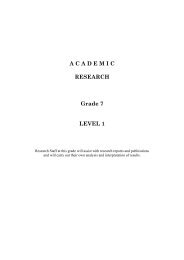Strategic Plan 2006 - Swansea University
Strategic Plan 2006 - Swansea University
Strategic Plan 2006 - Swansea University
Create successful ePaper yourself
Turn your PDF publications into a flip-book with our unique Google optimized e-Paper software.
Aim One – Research Excellence<br />
The <strong>University</strong> will, by the end of the planning period, be considered to be<br />
one of the top 30 institutions in the UK, with over 40% of its academic staff<br />
assessed to be producing research work of international quality and the<br />
remainder producing research work of national-level quality.<br />
Current Position<br />
The <strong>University</strong> has pursued a research strategy<br />
with two main elements: incremental growth<br />
through investing against business plans and<br />
diverting resources towards the most successful<br />
academic areas with the intention of<br />
developing interdisciplinary research activities,<br />
and quantum leap developments, based on<br />
large external investments, with the critical mass<br />
and level of funding to have significant impact<br />
on the <strong>University</strong>’s profile. Increasingly, the<br />
major scientific advances are being made at<br />
the boundaries between traditional disciplines,<br />
giving campus universities such as <strong>Swansea</strong><br />
a distinct advantage.<br />
The move to a School structure has been<br />
effected, releasing resources for research, with<br />
the academic areas that have been disinvested<br />
in integrated into the new Schools. New, and<br />
enhanced existing, research teams are<br />
embedding and developing capacity for the<br />
challenges ahead. Encouragingly, results of the<br />
investment in the <strong>University</strong>’s research capacity<br />
are already being seen. <strong>Swansea</strong> <strong>University</strong>’s<br />
annual income from the Research Councils has<br />
increased significantly year-on-year: in<br />
2004/05 it was £4.9m, whereas in the nine<br />
months from August 2005 it is already £7.5m.<br />
Overall research income has risen dramatically<br />
from £10.2m to in excess of £30m during the<br />
same time frame (reaching the <strong>University</strong>’s<br />
previous target two years early). Underlying<br />
these figures, the number of research grant<br />
applications submitted has increased to a level<br />
of at least 40 per month, from around 20 per<br />
month a year ago, which suggests a permanent<br />
increase in research income as well as the<br />
one-off increases gained from some of the<br />
large projects on campus.<br />
Within the Department of Research and<br />
Innovation, the Research and Innovation<br />
Office (RIO) is working to assist Schools in<br />
strengthening their research activities and in<br />
identifying opportunities for further funding<br />
support. The Department provides a single<br />
point of contact for academic staff within the<br />
<strong>University</strong> as well as for external partner<br />
organisations. This new, larger structure has<br />
been made possible by external funding and<br />
will ensure that <strong>Swansea</strong> stays firmly on course<br />
to become a <strong>University</strong> renowned for its focus<br />
not just on world-class research but also on<br />
using that research for wealth creation and, in<br />
particular, for the economic regeneration of<br />
South West Wales (Aim Six).<br />
Across the <strong>University</strong> there has been investment<br />
to strengthen many academic areas, including<br />
new research centres and specialisations.<br />
Some examples include: the Wales Institute of<br />
Cognitive Neuroscience (in collaboration with<br />
Cardiff <strong>University</strong> and UW Bangor) and the<br />
Wales International Centre for Childhood<br />
Studies, in Human Sciences; Centre for<br />
Research into the English Literature and<br />
Language of Wales, the Centre for Media<br />
History (with other universities) in the School<br />
of Arts; the Callaghan Centre for the Study of<br />
Conflict in Humanities; and investment in a<br />
new subject of Human-Computer Interaction in<br />
the School of Physical Sciences. The Research<br />
Committee has thoroughly reviewed the criteria<br />
for establishing, and the support for,<br />
interdisciplinary research centres.<br />
Science Research Investment Fund (SRIF) monies<br />
have been used to good effect to improve the<br />
infrastructure in, for example, Civil and<br />
Computational Engineering, the Institute of<br />
Environmental Sustainability, and the<br />
Biomolecular Analysis Mass Spectrometry<br />
Centre. In addition, Computer Science,<br />
Engineering and Medicine have successfully bid<br />
for eight Research Councils UK (RCUK)<br />
Fellowships, including four in Nanomedicine.<br />
The <strong>University</strong>’s Institute of Life Science (ILS) is<br />
under construction and on schedule to be ready<br />
for occupation by April 2007. It is a quantum<br />
leap project, a £50 million investment which<br />
represents a defining moment for the <strong>University</strong>,<br />
the largest research investment that has ever<br />
been made at <strong>Swansea</strong>. The ILS is designed to<br />
co-locate a number of life science related<br />
research centres of excellence in one highquality<br />
environment and draw on<br />
interdisciplinary research expertise from across<br />
the campus, enabling the School of Medicine to<br />
realise its full potential.<br />
The ILS will provide the highest quality scientific<br />
and computing facilities and will host IBM`s<br />
European Deep Computing Visualisation Centre<br />
for Medical Applications, with a new IBM<br />
supercomputer, ‘Blue C’, which is already on<br />
campus and in use. This is the fastest computer in<br />
the world dedicated to life science research, and<br />
the most powerful computer in any HEI in the UK.<br />
Objectives for the <strong>Plan</strong>ning Period<br />
In pursuing its aim of Research Excellence, the <strong>University</strong> will seek to:<br />
. double by 2007, relative to the 2001 RAE, the proportion of its<br />
research staff assessed to be producing research work of<br />
international quality.<br />
. reconfigure the <strong>University</strong> to achieve research critical mass in all<br />
academic areas, supporting this through infrastructure development.<br />
. only recruit staff that have achieved, or have the potential to achieve,<br />
international excellence in research.<br />
. proactively recruit distinguished scholars that can bring strong<br />
academic leadership to research teams in <strong>Swansea</strong>.<br />
. increase representation of <strong>Swansea</strong> <strong>University</strong> staff on Research<br />
Council panels and other funding agencies’ policy-making groups.<br />
. increase its income from Research Councils to £11.5m in 2008/09.<br />
. increase its research income from external sources other than the<br />
Research Councils to to £15.9m in 2008/09<br />
The other major quantum leap project that is<br />
already underway is the Institute for Advanced<br />
Telecommunications (IAT), launched in May<br />
<strong>2006</strong>. The IAT is a strategic project to create a<br />
world-class centre for telecommunications<br />
research in Wales, being a £17m investment<br />
underpinned by £5.2m of EU Objective One<br />
funds. It develops upon the substantial research<br />
strengths at <strong>Swansea</strong> in Engineering,<br />
Computing, Physics and Mathematics. The<br />
Institute will become a centre of excellence in<br />
modern telecommunications, and subsume and<br />
develop the role of the Communications and<br />
Photonics research group and the CETIC Centre<br />
for Communications and Software Technologies<br />
(CAST).<br />
The <strong>University</strong> is determined to ensure that<br />
the increase in research activity is suitably<br />
acknowledged and rewarded in the next<br />
Research Assessment Exercise (RAE). To help in<br />
its preparations for the RAE, a Working Group<br />
(RAE-WG) has been established to co-ordinate<br />
the management of the <strong>University</strong>’s return. The<br />
RAE-WG is comprised of the Vice Chancellor,<br />
senior academic staff and officers of the<br />
<strong>University</strong>, with other staff being invited to join<br />
the group when their expertise is required. The<br />
Group will assist Schools in making strategic<br />
decisions regarding the <strong>University</strong>’s RAE<br />
submissions based on the most comprehensive<br />
information available.<br />
Data has already been collected and analysed<br />
to quantify in detail the characteristics of an<br />
international-class research unit. <strong>Swansea</strong>’s<br />
current position, and that in 2001, has been<br />
assessed on a submission-by-submission basis.<br />
The findings have been reviewed by Senate<br />
and Management Board. Already, two (of<br />
three) such status reports have been published<br />
by the RAE-WG, and comprehensive advice<br />
given to Schools on the format of the RAE, as<br />
part of the <strong>University</strong>’s ongoing preparations.<br />
. promote excellence through international collaboration to achieve<br />
critical mass in consortium projects.<br />
. build networks between research groups and research and<br />
development in industry to promote knowledge transfer and raise<br />
awareness of the cutting-edge application of developments.<br />
. engage in a dialogue with businesses in Wales, and elsewhere in<br />
the UK, to identify potential research projects.<br />
. continue to support the commercialisation of the <strong>University</strong>’s research<br />
outputs through the Department of Research and Innovation and<br />
through the Technium network.<br />
. continue to develop further research collaborations with Welsh<br />
institutions, through Welsh Centres of Excellence and other research<br />
links with Welsh HE Institutions.<br />
. continue to work with public bodies to enhance the <strong>University</strong>’s<br />
research profile.<br />
04<br />
05


